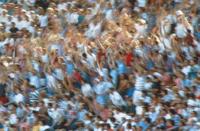Oakland A's and the Mexican Wave
I was able to take some time off of my hectic schedule to go to a baseball game last night. In Oakland, I saw the Athletics take on the Los Angeles Angels.
For a full 2 hours and 41 minutes I was a die hard Oakland A's fan. It was an excellent game and the excitement only grew in the 7th inning when the A's rallied and scored three runs. What happened next is what inspired this entry.
 During a slight lull in the 8th inning, as I inhaled my last dollar hotdog, something unique happened; the Mexican wave. If you've ever been to, or perhaps watched a major sporting event, you are probably well aware of this subject. “This wave sweeps around the audience in a stadium or sports arena, as firstly one group of people leap to their feet with their arms up and then sit down and then the group of people next to them does the same thing, and so on. If you're on the other side of the stadium looking across, you can see this beautifully rhythmic and synchronized movement rolling through the audience.” (Kruszelnicki)
During a slight lull in the 8th inning, as I inhaled my last dollar hotdog, something unique happened; the Mexican wave. If you've ever been to, or perhaps watched a major sporting event, you are probably well aware of this subject. “This wave sweeps around the audience in a stadium or sports arena, as firstly one group of people leap to their feet with their arms up and then sit down and then the group of people next to them does the same thing, and so on. If you're on the other side of the stadium looking across, you can see this beautifully rhythmic and synchronized movement rolling through the audience.” (Kruszelnicki) Mexican wave, or La Ola, rose to fame during the 1986 World Cup in Mexico. Many claim that it has taken place well before this time, but this was the first global broadcast of the wave.
Mexican wave, or La Ola, rose to fame during the 1986 World Cup in Mexico. Many claim that it has taken place well before this time, but this was the first global broadcast of the wave.
So why am I talking about this? Well, I got to thinking last night, (perhaps it was the beer,) that a good solid wave is dependent upon a number of variables. These include things like the shape of the stadium, weather, a lull in the game, starting pack, direction of the wave ect… I started thinking that perhaps someone out there has actually done serious study of the subject, perhaps even mapping some of these variables. I was right!
The wave usually rolls in a clockwise direction and typically moves at a speed of about 12 meters (or 20 seats) per second and has a width of about 6–12 m (corresponding to an average width of 15 seats). It is generated by no more than a few dozen people standing up simultaneously, and subsequently expands through the entire crowd as it acquires a stable, near linear shape. [2]
Last night I experienced a wave that rotated 6 full revolutions in a counter-clockwise direction at a pretty good pace. I was surprised with the number of revolutions since I assumed the law of diminishing returns would have thwarted the wave much sooner.
Again what I discovered is that the internet is an awesome place for finding out useless knowledge about random facts. Think of some of the lessons you’ve learned here the next time you see or participate in the Mexican Wave.

0 Comments:
Post a Comment
<< Home